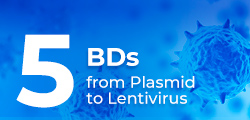-
REAGENT SERVICES
Hot!
-
Most Popular Services
-
Molecular Biology
-
Recombinant Antibody/Protein
-
Reagent Antibody
-
CRISPR Gene Editing
-
DNA Mutant Library
-
IVT RNA and LNP Formulations
-
Oligo Synthesis
-
Peptides
-
Cell Engineering
-
- CRISPR/Cas9 sgRNA
- CRISPR/Cas12a crRNA
- Prime Editing Guide RNA
- Base Editing Guide RNA
- HDR Templates
- gRNA + HDR Template Design Tools
- cGMP Guide RNA
- cGMP HDR Templates
- CRISPR/Cas Proteins
- CAR-T Knock-in Optimization Kit
- CRISPR Plasmids
- CRISPR gRNA Plasmid Libraries
- CRISPR Cell Lines
- Microbial Genome Editing
-
-
PRODUCTS
-
Most Popular Reagents
-
 Instruments
Instruments
-
Antibodies
-
ELISA Kits
-
Protein Electrophoresis and Blotting
-
Protein and Antibody Purification
-
Recombinant Proteins
-
Molecular Biology
-
Stable Cell Lines
-
Cell Isolation and Activation
-
 IVD Raw Materials
IVD Raw Materials
-
 Therapy Applications
Therapy Applications
-
Resources
-
- Pharmacokinetics and Immunogenecity ELISA Kits
- Viral Titration QC ELISA Kits
- -- Lentivirus Titer p24 ELISA KitHot!
- -- MuLV Titer p30 ELISA KitNew!
- -- AAV2 and AAVX Titer Capsid ELISA Kits
- Impurity Test ELISA Kits
- -- BSA ELISA Kit, 2G
- -- Cas9 ELISA KitNew!
- -- Protein A ELISA KitNew!
- -- His tagged protein detection & purification
- -- dsRNA ELISA Kit
- -- Endonuclease ELISA Kit
- COVID-19 Detection cPass™ Technology Kits
-
- Automated Maxi-Plasmid PurificationHot!
- Automated Mini-Plasmid PurificationNew!
- PCR Reagents
- S.marcescens Nuclease Benz-Neburase™
- DNA Assembly GenBuilder™
- Cas9 / Cas12a / Cas13a Nucleases
- Base and Prime Editing Nucleases
- GMP Cas9 Nucleases
- CRISPR sgRNA Synthesis
- HDR Knock-in Template
- CRISPR Gene Editing Kits and Antibodies
-
![AmMag™ Quatro Automated Plasmid Purification]() AmMag™ Quatro automated plasmid purification
AmMag™ Quatro automated plasmid purification
-
![Anti-Camelid VHH]() MonoRab™ Anti-VHH Antibodies
MonoRab™ Anti-VHH Antibodies
-
![ELISA Kits]() ELISA Kits
ELISA Kits
-
![Precast Gels]() SurePAGE™ Precast Gels
SurePAGE™ Precast Gels
-
![Quatro ProAb Automated Protein and Antibody Purification System]() AmMag™ Quatro ProAb Automated Protein and Antibody Purification System
AmMag™ Quatro ProAb Automated Protein and Antibody Purification System
-
![Target Proteins]() Target Proteins
Target Proteins
-
![AmMag™ Quatro Automated Plasmid Purification]() AmMag™ Quatro automated plasmid purification
AmMag™ Quatro automated plasmid purification
-
![Stable Cell Lines]() Stable Cell Lines
Stable Cell Lines
-
![Cell Isolation and Activation]() Cell Isolation and Activation
Cell Isolation and Activation
-
 IVD Raw Materials
IVD Raw Materials
-
![Quick
Order]() Quick Order
Quick Order
-
![Quick
Order]() Quick Order
Quick Order
- APPLICATIONS
- RESOURCES
- ABOUT US
- SIGN IN My Account SIGN OUT
- REGISTER
News & Blogs » CRISPR News » Advancing Infectious Disease Diagnosis with CRISPR Based Methods
Advancing Infectious Disease Diagnosis with CRISPR Based Methods
For infectious disease control, diagnostic tools that are reliable and deliver a fast read-out provide the best chance to stop re-infection cycles. The current coronavirus pandemic clearly illustrates the need for accurate and fast point of care diagnostics. Because an estimated ~18-30% of SARS-CoV-2 infected individuals remain asymptomatic, curving the spread of disease has been particularly challenging (Kimball et al. 2020, Lee et al. 2020, Mizumoto et al. 2020). For example, a recent study evaluated a cohort of over 300 SARS-CoV-2 infected patients, demonstrating similar viral load in both symptomatic and asymptomatic individuals (Lee et al. 2020). Although, viral load and infectivity were not correlated in this study, previous reports point towards a role of asymptomatic individuals in the spread of COVID-19 (Bai et al. 2020, Zhang et al. 2020). Therefore, tools that expedite diagnosis, even in the absence of symptoms, would not only help pandemic control efforts but would fast track life-saving treatments for those at high risk.
Expediting COVID Diagnostics
Traditionally, viral detection has relied on PCR based methodology, which is a highly specialized approach, requiring both experienced users as well as expensive equipment. The high-sensitivity and multiplex capability of real-time RT-PCR platforms make them the approach of choice for COVID diagnosis. Currently, one step RT-PCR allows for detection of SARS-CoV-2 from nasopharyngeal swabs, saliva, serum and stool (Carter et al. 2020). The main drawback of this approach during a pandemic is the time required for sample processing, which may be on the order of days to weeks.
In order to expedite diagnosis, several new methods have been developed, which leverage isothermal nucleic acid amplification strategies, such as loop-mediated isothermal amplification (LAMP) and recombinase polymerase amplification (RPA), to detect SARS-CoV-2. Isothermal amplification allows for independence from specialized instruments, such as thermocyclers. Therefore, this approach facilitates the development of rapid tests suitable for point of care diagnostics. For example, Abbott's ID Now point of care test, garnered attention early during the pandemic when it was authorized for emergency use by the FDA. The ID Now test relies on real-time RT- LAMP for qualitative detection of the SARS-CoV-2 RdRp gene, providing results within 13 minutes. Unfortunately, the accuracy of this test has been questioned, and the FDA has recommended the use of additional high-sensitivity tests for samples with negative results with ID Now.
CRISPR Based COVID Diagnostics
A new approach to viral nucleic acid detection leverages the specificity of both isothermal amplification and CRISPR/Cas detection. The CRISPR based SHERLOCK (Specific High-sensitivity Enzymatic Reporter UnLOCKing) method was first described in a Science article in 2017 for the detection of Zika and Dengue viruses, among other applications. SHERLOCK may prove to fill the need to expedite point of care pathogen detection, providing an affordable and simple, yet sensitive and specific diagnostic tool. Following amplification of viral RNA with RT-RPA and T7 transcription, SHERLOCK utilizes Cas13a-crRNA binding to target amplified viral-specific RNA, which triggers Cas13a's RNase activity on a non-specific RNA reporter (e.g., quenched fluorescent RNA), commonly referred to as "collateral cleavage". Compared to, ddPCR, qPCR or RPA alone, SHERLOCK demonstrated less variation across replicates (Gootenberg et al. 2020). Additionally, the hybridization step associated with CRISPR diagnostics can reduce nonspecific amplification associated with amplification-based methods (Patchsung et al. 2020).
Realizing the challenges imposed by the global COVID pandemic, the same group at the Broad Institute of MIT and Harvard, led by Dr. Feng Zhang, developed a SHERLOCK-based test for SARS-CoV-2, adapted for the Spike and Orf1b viral sequences (Zhang et al. 2020). To increase its accessibility for point of care diagnostics, a lateral flow dipstick is used to detect "collateral cleavage" providing a straightforward visual readout within 1 hour (Carter et al. 2020). Sherlock Biosciences and binx health have formed a global partnership to develop the first point-of-care COVID-test based on this CRISPR approach.

Mammoth Biosciences has developed its own CRISPR-based COVID diagnostic - the DETECTR assay. DETECTR utilizes RT-LAMP-mediated amplification of viral Nucleocapsid and Envelope sequences, and subsequent Cas12-mediated collateral cleavage of a ssDNA probe (Broughton et al. 2020). Similar to SHERLOCK COVID-19, the SARS-CoV-2 DETECTR test provides fast results, within 30-40 min, and may be also visualized by the use of lateral flow strips. GlaxoSmithKline and Mammoth Biosciences have partnered for the development of a DETECTR based test for COVID, envisioned as a hand-held and fully disposable device that will eventually be available for home use.
Most recently, to further streamline the SHERLOCK COVID-19 test and reduce the chance for cross-contamination, a new article in the medRxiv preprint service by the Zhang group describes the newest SHERLOCK version for COVID diagnosis (Joung et al. 2020). Investigators coined the name "STOPCOVID" (SHERLOCK Testing in One Pot) for this new test, which refers to its simplified workflow, where sample handling is minimized to a single transfer into the SHERLOCK reaction mix. To achieve this one pot configuration, STOPCOVID relies on LAMP and the collateral cleavage activity of AapCas12b-crRNA. This new SHERLOCK test version is less sensitive with a reported limit of detection of 100 molecules, but it can be used to analyze saliva or nasopharyngeal samples in as little as 40 minutes. The beauty of these approaches remains on the accessibility to an easy and effective diagnostic tool, which would empower disease management even in the most adverse and remote locations.

Real-time RT-PCR CRISPR (DETECTR) Advantages √ Multiplex
√ High sensitivity
√ High specificity
√ Test time 120-140 min√ Results within 1 hour, 45-70 min
√ Point-of-care/immediate results
√ Simple read-out (positive/negative)
√ Easy to use/No instruments
√ Single nucleotide target specificityDisadvantages √ Samples sent to reference labs
√ Specialized instrumentation
√ Complex data
√ Analysis time (4-6 hrs)
√ Long turnaround time (days)
√ May have false-positive and false-negative results
√ High cost√ One sample per test
√ Potential off-target reactivitySensitivity (LOD) 1 copy/μL*
0.15-100 copy/μL**10 copies/μL*
2-10 copy/μL**(*Based on comparison of CDC qRT-PCR assay to DETECTR lateral flow assay as tested in Broughton et al. 2020; **Giri et al. 2020)
Reference
- Bai, Y. et al. Presumed Asymptomatic Carrier Transmission of COVID-19. JAMA - Journal of the American Medical Association (2020) doi:10.1001/jama.2020.2565.
-
Broughton, J. P. et al. CRISPR–Cas12-based
detection of SARS-CoV-2. Nat. Biotechnol. (2020)
doi:10.1038/s41587-020-0513-4. - Carter, L. J. et al . Assay Techniques and Test Development for COVID-19 Diagnosis. ACS Cent. Sci. (2020) doi:10.1021/acscentsci.0c00501.
- Giri, B. et al. Review of analytical performance of COVID 19 detection methods. Anal Bioanal Chem. (2020) doi: 10.1007/s00216-020-02889-x.
-
Gootenberg, J. S. et al. Nucleic acid detection
with CRISPR-Cas13a/C2c2. Science (80-. ). (2017)
doi:10.1126/science.aam9321. - Joung, J. et al. Point-of-care testing for COVID-19 using SHERLOCK diagnostics. medRxiv Prepr. Serv. Heal. Sci. (2020) doi:10.1101/2020.05.04.20091231.
- Kimball, A. et al. Asymptomatic and Presymptomatic SARS-CoV-2 Infections in Residents of a Long-Term Care Skilled Nursing Facility — King County, Washington, March 2020. MMWR. Morb. Mortal. Wkly. Rep. (2020) doi:10.15585/mmwr.mm6913e1.
- Lee, S. et al. Clinical Course and Molecular Viral Shedding among Asymptomatic and Symptomatic Patients with SARS-CoV-2 Infection in a Community Treatment Center in the Republic of Korea. JAMA Intern. Med. (2020) doi:10.1001/jamainternmed.2020.3862.
- Mizumoto, K., Kagaya, K., Zarebski, A. & Chowell, G. Estimating the asymptomatic proportion of coronavirus disease 2019 (COVID-19) cases on board the Diamond Princess cruise ship, Yokohama, Japan, 2020. Eurosurveillance (2020) doi:10.2807/1560-7917.ES.2020.25.10.2000180.
- Patchsung, M. et al. Clinical validation of a Cas13-based assay for the detection of SARS-CoV-2 RNA. Nat. Biomed. Eng. (2020) doi:10.1038/s41551-020-00603-x.
- Zhang, F., Abudayyeh, O. O., Gootenberg, J. S., Sciences, C. & Mathers, L. A protocol for detection of COVID-19 using CRISPR diagnostics. Bioarchive (2020).
- Zhang, J., Tian, S., Lou, J. & Chen, Y. Familial cluster of COVID-19 infection from an asymptomatic. Critical Care (2020) doi:10.1186/s13054-020-2817-7.
Subscribe to Receive Updates
& Promotions From GenScript* We'll never share your email address with a third-party.
Latest News & Blogs
Find More CRISPR NewsCRISPR Screening to Optimize CAR Therapies | GenScript

Engineered NK cells, off-the-shelf solution | GenScript

Multiplex Editing T Cells with BE and Cas12 | GenScript

Evolving in vivo Gene and Editing-Cargo Delivery Strategies | GenScript

Enabling Non-Viral T Cell Engineering with ssDNA HDR Templates

CRISPR/Cas9 Based Screens Advancing Cell Therapies


-






































